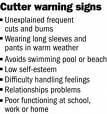Bipolar disorder self injury is very misunderstood.
Often, even the best resources on bipolar disorder neglect this important bipolar symptom.

Accurate information on bipolar disorder would make it clear that bipolar is about extreme moods and that the tell-tale symptoms of bipolar disorder revolve around these mood swings into mania and depression.
Oftentimes, people confuse bipolar disorder (manic-depressive illness) with other conditions such as Borderline Personality Disorder (BPD) and even psychosis. BPD can co-occur with Bipolar Disorder, but they are two separate disorders with distinct symptoms. The same applies to psychosis: Psychotic symptoms can occur during manic or depressive episodes, but psychosis that is characteristic of disorders like Schizophrenia is also a separate diagnosis from Bipolar Disorder.
The current trend towards labeling any teen with conduct issues as “bipolar”, and the publicity and mixed messages around “cutting” and other forms of self-injury, lead many people to equate these things. In fact, they are often unrelated.
In particular, the contemporary forms of self injury that currently garner so much publicity – I am thinking in particular of cutting – DO NOT APPEAR ANYWHERE in the official DSM diagnosis of bipolar disorder. Clinically, bipolar is all about mania and depression. Self-injury per se is not part of the diagnostic criteria for bipolar disorder and there is no necessary relationship between the two.1
However, many people search the Internet for information on bipolar disorder and write to me about bipolar disorder self injury, assuming that cutting is always bipolar symptom. This is simply not true.

According to experts:
“[Self injury] is listed in the Diagnostic and Statistical Manual of Mental Disorders (DSM-IV-TR) as a symptom of borderline personality disorder and depressive disorders. It is sometimes associated with mental illness, a history of trauma and abuse including emotional abuse, sexual abuse, eating disorders, or mental traits such as low self-esteem or perfectionism”.
Learn about the difference between self injury in Bipolar vs Borderline Personality Disorder.
This is not to say there is not good reason for the confusion, or that it is true to say that bipolar disorder and self injury NEVER go together. For example, self-mutilation is significantly correlated with impulsiveness, chronic anger, and anxiety. Bipolar is also strongly correlated with impulsiveness, anger, and anxiety. Learn more about self injury and bipolar.
Interestingly, self injury is often treated with SSRI type antidepressants such as Zoloft or Prozac. These are generally unsuitable medications for treating bipolar as they may trigger manic episodes. This is all part of the confusion around bipolar disorder self injury.
Types of self harm in bipolar disorder
Despite the remarks above, I do believe there is a lot to say about bipolar disorder self injury.
There are are many types of self harm that manifest in bipolar symptoms. The most dangerous is bipolar suicides.
Many studies indicate a 15% rate of suicide amongst individuals with bipolar disorder. This rate is about 30 times higher than than that of the general population.
Some studies have come up with rates as high as 30%-50%.
More recent studies, however, have been finding lower rates. There are two reasons for this. The first reason is that now studies tend to take in a wider range of bipolar people, whereas earlier studies focused on patients who were already hospitalized and therefore in a greater state of symptom severity. The second reason is the increase in the use of lithium and other medications that effectively
treat bipolar.
The absolute most conservative figure suggested for patients diagnosed today is AT LEAST a 5% lifetime suicide risk.
There are other statistics that illustrate how bipolar disorder can effect every aspect of a person’s life and the many types of self harm in bipolar disorder.

For example:
1. Bipolar people are TWICE as likely to have gambling problems.
2. Bipolar people are THREE times as likely to smoke.
3. A recent study of bipolar teens found a significantly higher risk of drug or alcohol abuse or addiction – 31% compared with just 4% in the non-bipolar control group.
4. People with mental health problems are THREE times more likely to accumulate huge debts than the general population, and amongst those with bipolar disorder the number is more likely to be higher. This is because over-spending is part of the condition.
5. Preventable cardiovascular disease is the number one killer of people with bipolar disease. Bipolar people also have a lower physical quality of life. This could be due to some of the types of self harm already mentioned – a higher consumption of addictive substances such as alcohol and tobacco, the long-term secondary effects of the pharmacological treatment and a more sedentary way of life.
6. Bipolar people have higher rates of divorce and relationship breakdown. In important research, hypersexuality was reported in 57% of manic individuals, based on averages across seven studies, with a range of values from 25% to 80%!

7. Research has also identified what is called “downward drift” amongst people with bipolar disorder (Goodwin and Jamison, 2007). This is where, compared to non-bipolar family members, bipolar people eventually end up with lower levels of wealth and income.
Why are people with bipolar disorder prone to so many types of self harm? We have looked at some specific types of bipolar disorder self injury. Anger, recklessness, impulsiveness and poor judgment are common in Bipolar Disorder.
These bipolar signs and symptoms are a dangerous cocktail when mixed with the low self-esteem, shame, and frustration that many people living with manic-depressive illness constantly are frequently coping with.2
References:
1https://www.ncbi.nlm.nih.gov/pubmed/20180727
2https://jamanetwork.com/journals/jamapsychiatry/fullarticle/2521461
 Medically reviewed by
Medically reviewed by